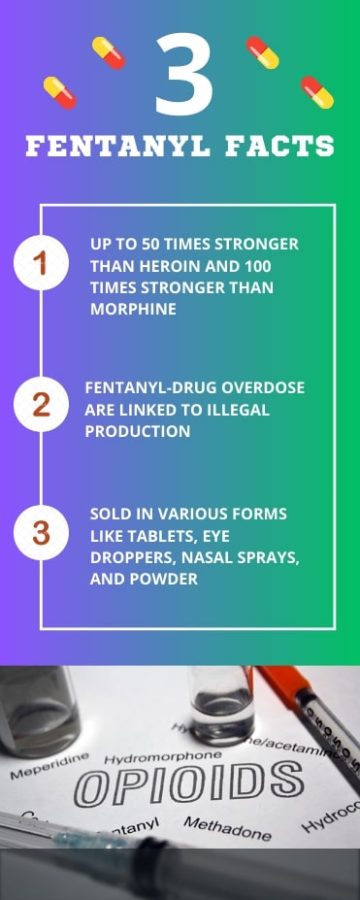Fentanyl Poisoning
April 19, 2023
*The opinions expressed within the content are solely the author’s and do not reflect the website’s or its affiliates’ opinions and beliefs.*
In 2021, the CDC reported that 107,622 people in the United States died from drug overdoses. Alarmingly, a significant number of these deaths were teenagers, with adolescent deaths increasing by 20 percent in the same year. Many of these deaths were attributed to the use of fentanyl, a pharmaceutical medication typically given to cancer patients with severe pain but also produced illegally. Illicit synthetic fentanyl is sold in various forms such as tablets, eye droppers, blotter paper, nasal sprays and powder, often disguised as other prescription opioids. The increasing number of teen overdoses is not solely the fault of the individuals, as fentanyl is an attractive and affordable alternative to other drugs. However, the opioid crisis is exacerbated by the fact that fentanyl can be easily laced with other substances like heroin, cocaine, methamphetamine and Percocet, leading to a high number of fatal overdoses. Thus, schools need to implement a stronger response to drug use to ensure the safety of their students.
While simply instructing students not to take drugs might be effective for some, many young individuals aren’t fully mature, meaning they are inclined to turn to these options when facing adverse situations. For instance, Zach Didler was a 17-year-old boy who passed away after ingesting a fentanyl-laced Percocet. A “plug,” or claimed drug dealer, sold the substance to the young teen as he had been struggling with his mental health. According to Dr. Scott Hadland, the head of Adolescent and Young Adult Medicine at Boston’s Massachusetts General for Children Hospital, “about two out of every five teens who overdose has a history of struggling with depression, anxiety or other mental health problems, and in many cases, these problems have gone unaddressed.” Therefore, schools must prioritize mental health care and support systems for their students. If young individuals can find other coping mechanisms when facing adverse circumstances or poor mental health, they wouldn’t be inclined to turn to drugs in the first place.
In addition to supporting student’s mental health, schools need to take appropriate action in response to drug use. For instance, Melanie Ramos, a 15-year-old teenager, was discovered dead in a Bernstein High School restroom after ingesting a fentanyl-laced tablet. Her aunt, Gladys Manriquez, stated, “When we send our kids to school, we send them thinking they’re safe . . . but that’s not happening.” The purpose of school is for students to learn and prepare for their future. What kind of future is there if students are dying in these schools? To prevent such incidents from occurring, students must be taught about the dangers of drug use and how it can lead to fatal consequences. Education on the negative effects of drug use can be instrumental in preventing students from turning to opioids in the first place. For example, the expansion of drug prevention programs like the D.A.R.E. (Drug Abuse Resistance Education) program can be useful in this regard. Furthermore, schools must protect against overdoses, such as the availability of Narcan, a drug that can reverse opioid overdoses. Governor Gavin Newsom’s request for $3.5 million to fund the distribution of naloxone to middle and high schools is a significant step in the right direction. All in all, schools must respond to the opioid crisis more intensely, both preventing the use of drugs at the source and improving secondary measures to keep an individual alive.
Teenagers losing their lives to drug overdoses is a tragedy that must be addressed. Schools must implement better systems and measures to ensure the safety of their students. The opioid crisis is a complex issue that requires a multifaceted approach involving mental health care, education and protection against overdoses. Only by taking swift and appropriate action can we prevent further loss of life and protect younger generations.






